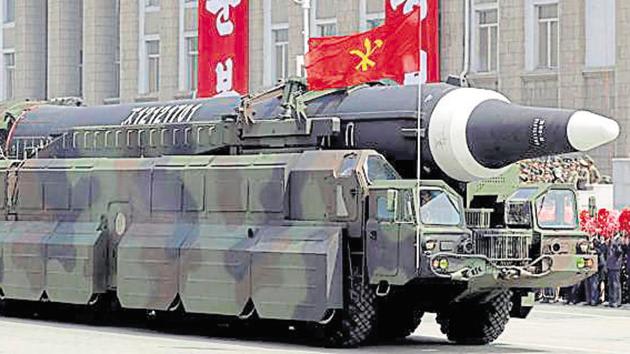
On March 5, the Nuclear Non-Proliferation Treaty (NPT) turned 50. Often described by its supporters as the “cornerstone of global nuclear non-proliferation and disarmament”, the NPT is among the most widely-adhered-to global treaties. All countries except four (India, Israel and Pakistan that never joined, and North Korea that withdrew in 2003) are parties to the NPT.
Yet, the NPT’s golden anniversary passed without much notice. A statement issued in New York by the spokesperson for the United Nations (UN) secretary general was notable for its brevity and anodyne character. There are suggestions that the NPT Review Conference, due to open in New York on April 27, be postponed, on account of the coronavirus outbreak, but it will also have the effect of avoiding a potentially bruising showdown.
In 1963, President Kennedy voiced an apprehension that by 1975, there could be as many as 20 countries with nuclear weapons. The erstwhile USSR shared similar concerns. This convergence of interests between the two Cold War adversaries enabled the negotiations for an NPT.
To make it attractive, it was initially conceived as a three-legged stool — non-proliferation, obliging those without nuclear weapons to undertake never to acquire them and accept full-scope safeguards; disarmament, obliging the five countries with nuclear weapons (United States, USSR, United Kingdom, France and China) to negotiate to reduce and eventually eliminate their nuclear weapons; and, third, to ensure that non-nuclear weapon states would enjoy full access to peaceful applications of nuclear science and technology.
By the time the negotiations ended in 1968, India had concluded that the disarmament leg was too weak and the definition of a nuclear-weapon State (one that had exploded a nuclear device before January 1,1967) was one that created a permanent division between nuclear haves and have-nots; it chose to stay away.
Among the oft-cited successes of the NPT is the dramatic reduction in the number of nuclear weapons from a peak of 70,300 warheads in 1986 to around 14,000 at present, with the US and Russia accounting for over 12,500. What is overlooked is that nearly all the reductions happened between 1990 and 2010, and the process has now dwindled to a halt. More significantly, these reductions were a result of bilateral talks between the US and Russia, reflecting their state of relations, and no negotiations have ever been held in the NPT framework. In fact, during the first 15 years of the NPT, the US-Soviet arsenals went up from below 40,000 to over 70,000, making it abundantly clear that the NPT nuclear-weapon-states have blithely ignored the disarmament leg of the NPT.
The NPT has successfully prevented proliferation. Since 1970, only four countries have acquired nuclear weapons, bringing the total number of nuclear-weapon-states to nine, much less than Kennedy’s apprehensions in 1963. However, it brings out the uncomfortable reality that the NPT has no means of dealing with these four states.
The five nuclear weapon states recognised by the NPT (N-5) are also the five permanent members of the UN Security Council (P-5), giving rise to the inevitable conclusion that nuclear weapons remain the currency of political and military power. This conclusion can only encourage potential proliferators by making nuclear weapons more attractive as the ultimate security guarantor.
The NPT’s supporters also claim credit for strengthening the taboo against nuclear weapons by pointing out that nuclear weapons have never been used since 1945. However, a closer examination of recently declassified papers indicates that since 1970, there were over a dozen instances where the US and USSR came close to initiating a nuclear exchange, often based on misperceptions about the intentions of the other or plain system errors. Even today, US and Russia maintain over 1,000 nuclear weapons on hair trigger alert, increasing the risks of an accidental or inadvertent nuclear exchange.
Today, the nuclear taboo is being challenged as major nuclear powers undertake research and development for more usable low-yield nuclear weapons. Ballistic missile defence, hypersonic systems that carry both conventional and nuclear payloads, and growing offensive cyber capabilities further blur the line between conventional and nuclear.
Frustrated by the lack of responsiveness on the part of the N-5, 120 countries party to the NPT joined hands with civil society to push negotiations for a Treaty on the Prohibition of Nuclear Weapons (TPNW), concluded in 2017. These countries had concluded that despite near universal adherence, the NPT could never be the vehicle for nuclear disarmament. It had delegitimised proliferation, but done little to delegitimise nuclear weapons. And in the process, the NPT had reached the limits of its success. The N-5 and their allies boycotted the negotiations but the existence of the TPNW exposes the inherent imbalance in the NPT’s three-legged stool.
The uncomfortable truth is that the old nuclear arms control model reflected the political reality of the Cold War. Today’s reality reflects multipolarity, marked by asymmetry. It is hardly surprising that the US-USSR treaties of the bipolar era, like the ABM Treaty or the INF Treaty are already dead, and others like the New START and Open Skies Treaty are being challenged.
The NPT faces a similar challenge, of continued political relevance. Unless the NPT members, especially the N-5 realise this, its golden anniversary may well mark the onset of NPT’s mid-life crisis.
Sign on to read the HT ePaper epaper.hindustantimes.com